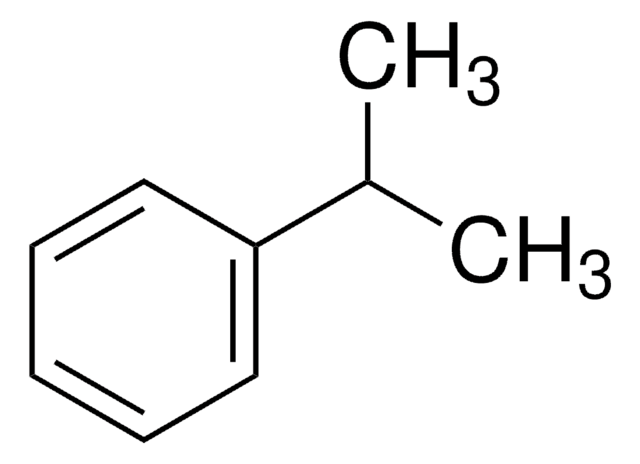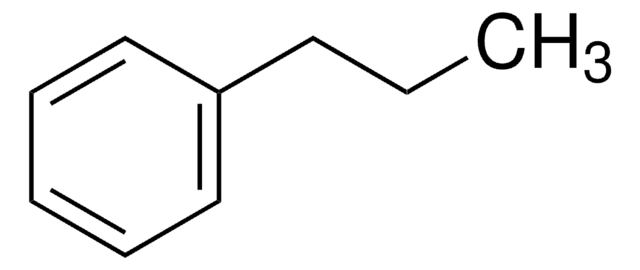28220
Cumene
analytical standard
Sinônimo(s):
(1-Methylethyl)benzene, 2-Phenylpropane, Isopropylbenzene, NSC 8776
About This Item
Produtos recomendados
grau
analytical standard
Nível de qualidade
densidade de vapor
4.1 (vs air)
pressão de vapor
8 mmHg ( 20 °C)
9.7 mmHg ( 37.7 °C)
Ensaio
≥99.5% (GC)
temperatura de autoignição
797 °F
prazo de validade
limited shelf life, expiry date on the label
Lim. expl.
6.5 %
técnica(s)
HPLC: suitable
gas chromatography (GC): suitable
índice de refração
n20/D 1.491 (lit.)
n20/D 1.491
pb
152-154 °C (lit.)
pf
−96 °C (lit.)
densidade
0.864 g/mL at 25 °C (lit.)
aplicação(ões)
environmental
formato
neat
temperatura de armazenamento
2-8°C
cadeia de caracteres SMILES
CC(C)c1ccccc1
InChI
1S/C9H12/c1-8(2)9-6-4-3-5-7-9/h3-8H,1-2H3
chave InChI
RWGFKTVRMDUZSP-UHFFFAOYSA-N
Procurando produtos similares? Visita Guia de comparação de produtos
Descrição geral
Aplicação
Palavra indicadora
Danger
Frases de perigo
Declarações de precaução
Classificações de perigo
Aquatic Chronic 2 - Asp. Tox. 1 - Carc. 1B - Flam. Liq. 3 - STOT SE 3
Órgãos-alvo
Respiratory system
Código de classe de armazenamento
3 - Flammable liquids
Classe de risco de água (WGK)
WGK 3
Ponto de fulgor (°F)
87.8 °F - closed cup
Ponto de fulgor (°C)
31.0 °C - closed cup
Equipamento de proteção individual
Eyeshields, Faceshields, Gloves, type ABEK (EN14387) respirator filter
Choose from one of the most recent versions:
Já possui este produto?
Encontre a documentação dos produtos que você adquiriu recentemente na biblioteca de documentos.
Os clientes também visualizaram
Nossa equipe de cientistas tem experiência em todas as áreas de pesquisa, incluindo Life Sciences, ciência de materiais, síntese química, cromatografia, química analítica e muitas outras.
Entre em contato com a assistência técnica









